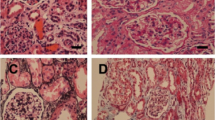Abstract
Background
Glomerulopathy with fibronectin deposits (GFND) is a rare autosomal dominant disease characterized by massive fibronectin deposits, leading to end-stage renal failure. Although mutations within the heparin-binding domains of the fibronectin 1 gene (FN1) have been associated with GFND, no mutations have been reported within the integrin-binding domains.
Methods
In this study, FN1 mutational analysis was conducted in 12 families with GFND. Biochemical and functional features of mutated proteins were examined using recombinant fibronectin fragments encompassing both the integrin- and heparin-binding domains.
Results
We report six FN1 mutations from 12 families with GFND, including five that are novel (p.Pro969Leu, p.Pro1472del, p.Trp1925Cys, p.Lys1953_Ile1961del, and p.Leu1974Pro). p.Pro1472del is localized in the integrin-binding domain of fibronectin, while the others are in heparin-binding domains. We detected p.Tyr973Cys, p.Pro1472del, and p.Leu1974Pro mutations in multiple families, and haplotype analysis implied that p.Pro1472del and p.Leu1974Pro are founder mutations. The protein encoded by the novel integrin-binding domain mutation p.Pro1472del showed decreased cell binding ability via the integrin-binding site. Most affected patients developed urine abnormalities during the first or second decade of life, and some mutation carriers were completely asymptomatic.
Conclusions
This is the second large-scale analysis of GFND families and the first report of an integrin-binding domain mutation. These findings may help determine the pathogenesis of GFND.




Similar content being viewed by others
References
Ruoslahti E (1988) Fibronectin and its receptors. Annu Rev Biochem 57:375–413
Schwarzbauer JE (1991) Fibronectin: from gene to protein. Curr Opin Cell Biol 3:786–791
George EL, Georges-Labouesse EN, Patel-King RS, Rayburn H, Hynes RO (1993) Defects in mesoderm, neural tube and vascular development in mouse embryos lacking fibronectin. Development 119:1079–1091
Petersen TE, Thogersen HC, Skorstengaard K, Vibe-Pedersen K, Sahl P, Sottrup-Jensen L, Magnusson S (1983) Partial primary structure of bovine plasma fibronectin: three types of internal homology. Proc Natl Acad Sci U S A 80:137–141
Pierschbacher MD, Ruoslahti E (1984) Variants of the cell recognition site of fibronectin that retain attachment-promoting activity. Proc Natl Acad Sci U S A 81:5985–5988
Obara M, Kang MS, Yamada KM (1988) Site-directed mutagenesis of the cell-binding domain of human fibronectin: separable, synergistic sites mediate adhesive function. Cell 53:649–657
Benecky MJ, Kolvenbach CG, Amrani DL, Mosesson MW (1988) Evidence that binding to the carboxyl-terminal heparin-binding domain (Hep II) dominates the interaction between plasma fibronectin and heparin. Biochemistry 27:7565–7571
Ingham KC, Brew SA, Atha DH (1990) Interaction of heparin with fibronectin and isolated fibronectin domains. Biochem J 272:605–611
Barkalow FJ, Schwarzbauer JE (1991) Localization of the major heparin-binding site in fibronectin. J Biol Chem 266:7812–7818
Laterra J, Norton EK, Izzard CS, Culp LA (1983) Contact formation by fibroblasts adhering to heparan sulfate-binding substrata (fibronectin or platelet factor 4). Exp Cell Res 146:15–27
Woods A, Couchman JR, Johansson S, Hook M (1986) Adhesion and cytoskeletal organisation of fibroblasts in response to fibronectin fragments. EMBO J 5:665–670
Haugen PK, McCarthy JB, Skubitz AP, Furcht LT, Letourneau PC (1990) Recognition of the A chain carboxy-terminal heparin binding region of fibronectin involves multiple sites: two contiguous sequences act independently to promote neural cell adhesion. J Cell Biol 111:2733–2745
Strom EH, Banfi G, Krapf R, Abt AB, Mazzucco G, Monga G, Gloor F, Neuweiler J, Riess R, Stosiek P, HebertLA SDD, Gudat F, Mihatsch MJ (1995) Glomerulopathy associated with predominant fibronectin deposits: a newly recognized hereditary disease. Kidney Int 48:163–170
Castelletti F, Donadelli R, Banterla F, Hildebrandt F, Zipfel PF, Bresin E, Otto E, Skerka C, Renieri A, Todeschini M, Caprioli J, Caruso RM, Artuso R, Remuzzi G, Noris M (2008) Mutations in FN1 cause glomerulopathy with fibronectin deposits. Proc Natl Acad Sci U S A 105:2538–2543
Acknowledgments
The results presented in this paper have not been published previously in whole or part, except in abstract format. This work was supported by a Grant-in-Aid for Young Scientists (B) (KAKENHI) from the Ministry of Education, Culture, Sports, Science, and Technology, Japan (Subject ID: 24791062 to Hiromi Ohtsubo). We thank T. Kajimoto, S. Miya, C. Hirai, Y. Hashimura, T. Ninchoji, N. Morisada, S. Ishimori, F. Hashimoto, N. Matsunoshita, N. Kamyoshi, S. Minamikawa, and T. Yamamura for technical assistance and/or encouragement. Special thanks go to K. Jo, T. Okamoto, S. Sasaki, M. Fujieda, T. Kawanishi, T. Harada, A. Inaba, N. Miura, M. Toyoda, M. Nishida, H. Itoh, T. Udagawa, R. Katabuchi, N. Gotoh, O. Uchikoga, H. Fujii, K. Aramaki, S. Okuda, T. Kurosawa, K. Koike, Y. Hori, N. Uesugi, N. Miura, S. Isobe, K. Ishiyama, and S. Hirashio.
Author information
Authors and Affiliations
Corresponding author
Ethics declarations
All procedures performed in studies involving human participants were in accordance with the ethical standards of the institutional and/or national research committee and with the 1964 Helsinki Declaration and its later amendments or comparable ethical standards. This article does not contain any studies with animals performed by any of the authors.
Conflict of interest
The authors have no conflicts of interest to disclose.
Informed consent
Informed consent was obtained from all individual participants included in the study.
Funding
This study was supported by a Grant-in-Aid for Young Scientists (B) (KAKENHI) from the Ministry of Education, Culture, Sports, Science, and Technology, Japan (Subject ID: 24791062 to Hiromi Ohtsubo).
Additional information
Hiromi Ohtsubo, Taro Okada and Kandai Nozu should be regarded as joint first authors.
Electronic supplementary material
Below is the link to the electronic supplementary material.
ESM 1
(DOCX 1760 kb)
Rights and permissions
About this article
Cite this article
Ohtsubo, H., Okada, T., Nozu, K. et al. Identification of mutations in FN1 leading to glomerulopathy with fibronectin deposits. Pediatr Nephrol 31, 1459–1467 (2016). https://doi.org/10.1007/s00467-016-3368-7
Received:
Revised:
Accepted:
Published:
Issue Date:
DOI: https://doi.org/10.1007/s00467-016-3368-7




